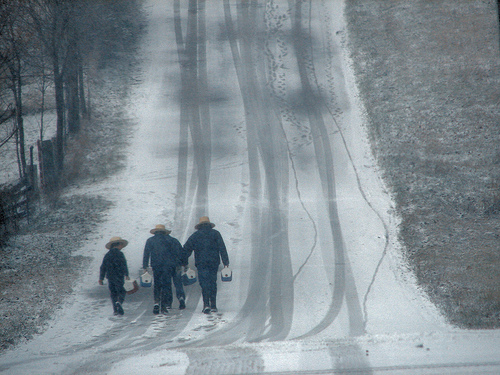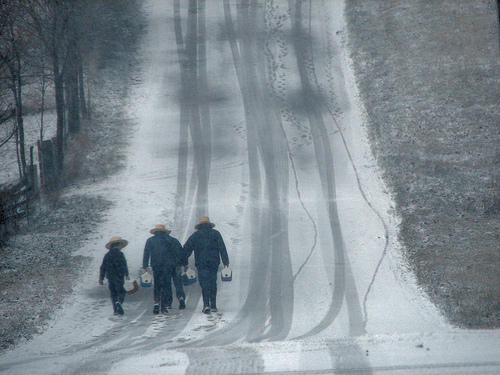 Getting to school the old-fashioned way in Amish Country in Indiana.Photo courtesy of Cindy Seigle via Flickr.I live in one of the most walkable communities in the United States. That’s not just my opinion — my neighborhood of Cobble Hill, Brooklyn, rates a 100 on the Walk Score tool.
Getting to school the old-fashioned way in Amish Country in Indiana.Photo courtesy of Cindy Seigle via Flickr.I live in one of the most walkable communities in the United States. That’s not just my opinion — my neighborhood of Cobble Hill, Brooklyn, rates a 100 on the Walk Score tool.
So it burns me up how many kids at my son’s school get dropped off by their parents in cars. Sure, some of them come from surrounding neighborhoods (it’s a private school). Still, there are multiple subway and bus stops within a two-to-five minute walk from the schoolhouse door. I’ve had one parent tell me her perfectly robust 10-year-old daughter simply “doesn’t want to” walk the mile from her house, a 20-minute trip along quiet, tree-lined streets. So, against her better judgment, this woman fires up the car.
The parents who drive are constantly kvetching about not being able to find parking spaces, getting expensive tickets, and fighting traffic. Many of them double-park and idle outside the school, creating dangerous traffic conditions and spewing fumes into the groups of kids on the sidewalk.
Many of these people would probably make blood sacrifices to advance their kids’ prospects of getting into a top high school/college/PhD program down the road. These are children who have been fed organic produce since their first spoonful of applesauce. When it comes to the health and mental benefits of walking instead of driving, though, the perceived convenience of a car mysteriously wins out.
I’m seriously considering handing out fliers at drop-off one day letting people know about recent research on the subject. It suggests that the simple act of walking to school can reduce children’s stress levels and improve their lifetime cardiovascular health.
People would think I’m nuts, but so what? The whole thing does make me crazy — especially because almost all these people could be choosing more active, healthier modes of transportation.
In much of the United States, families aren’t that lucky. Walking or biking to class is not an option. In some school districts, it has actually been banned.
More often, though, especially in the case of suburbs, streets are designed solely for the automobile. Travel by foot is unpleasant at best, dangerous at worst.
Today the Strong Towns blog published a rant by Charles Marohn about what he’s observed getting his daughter to kindergarten in Baxter, Minn.:
The school has designed their parking lot so that parents can actually queue in their cars along a designated pickup route like they were at a McDonald’s drive thru. When they get near the front of the line, they give their McChild’s name to a lady with a blowhorn who shouts out said name. At this point, the McChild dutifully reports to the curb …
We drive to school. Even if we lived close enough, you can’t walk, despite the fact that the school district policy is not to pick up anyone who lives within a half mile. Sorry, kindergartner from a family in poverty that does not have two cars (or two parents) and nobody is available to drive you. You get to walk 2,640 feet through a car-only environment, playing Frogger across the highway if you are lucky enough to avoid getting knocked into the ditch on your way there …
When we collectively don’t bother to consider that driving at speed through a residential neighborhood next to a school just prior to opening bell may not be the best policy, but instead we condition our entire built environment to handle our 2-ton prosthetic devices, we know we have a problem.
It’s a grim scene. In many places, though, things are changing for the better. Hundreds of communities are actively encouraging kids to walk or bike instead of traveling by car. In Boulder, Colo., the city has built miles of protected bike lanes as well as upgrading sidewalks and intersections to make walking safer. At a school in Portland, Ore., where kids were once banned from biking, they are now happily riding, skateboarding, and scootering their way to class. Many places, like Westhaven, Tenn., have instituted “walking buses,” in which parents take turns shepherding groups of young children to school on foot.
Children don’t learn only at school. We should remember that when we decide how they get there.
Get Off Your Ass Alert: Want to make it easier for kids to get to school under their own power where you live? Get started with some resources from the National Center for Safe Routes to School.



